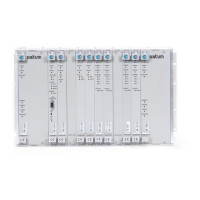Antennas
Installing Antennas
404 SSU-2000 User’s Guide 12713020-002-2 Revision D – April 2004
All antenna kits supplied use LMR-400, or equivalent, low-loss coaxial cable. Other
types of coaxial cable are available for GPS antenna applications; however, it is
imperative that you calculate the specific cable loss to ensure a signal level
between 13.8 dB and 36.8 dB at the antenna connector input. The L1 signal loss of
LMR-400 is 1.67 dB/meter. The L1 signal loss of a 90 v transient eliminator is
typically 0.25 dB.
GPS Antenna With a Low Noise Amplifier, 26, 40, 48, or 68 dB
The Marine 26, 40, 48, or 68 dB GPS Antenna with a Low Noise Amplifier (LNA)
receives the GPS signal from each satellite, and amplifies the 1,575 MHz (L1)
signal and feeds it to the SSU-2000. The amplified L1 signal and 5 vDC power are
carried over the coaxial antenna cable connecting the units. The antenna is housed
in a weatherproof package suitable for permanent installation in an exposed
location.
The antenna-to-radio receiver cable should be kept to the shortest reasonable
length. For additional transient eliminator protection requirements, you can install a
250B-90 Gas Tube transient eliminator in series with the antenna coaxial cable.
Installing the Transient Eliminator
If you are installing a transient eliminator, follow these guidelines:
Transient eliminators should be installed in accordance with your antenna system
grounding scheme
Mount the transient eliminator within 9 meters of the GPS antenna
If required, mount a second transient eliminator near the GPS antenna
To install the transient eliminator:
1. If necessary, cut the coaxial cable and install mating connectors (see the
Warning in Cutting Antenna Cables, on page 403).
2. Using the DVM, measure the resistance between the center conductor and
shield to verify that the center conductor and shield are not shorted together.
3. Connect the longer GPS antenna coaxial cable to the transient eliminator.
4. Connect the ground wire between the transient eliminator and the proper
grounding zone (building ground, master ground bar, or other) for the mounting
location.
Note: Step 6 in the following procedure cannot be done if you cut the
cable (as described in Step 1).

